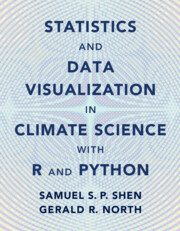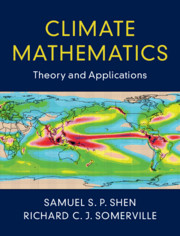Statistics and Data Visualization in Climate Science with R and Python
A comprehensive overview of essential statistical concepts, useful statistical methods, data visualization, and modern computing tools for the climate sciences and many others such as geography and environmental engineering. It is an invaluable reference for students and researchers in climatology and its connected fields who wish to learn data science, statistics, R and Python programming. The examples and exercises in the book empower readers to work on real climate data from station observations, remote sensing and simulated results. For example, students can use R or Python code to read and plot the global warming data and the global precipitation data in netCDF, csv, txt, or JSON; and compute and interpret empirical orthogonal functions. The book's computer code and real-world data allow readers to fully utilize the modern computing technology and updated datasets. Online supplementary resources include R code and Python code, data files, figure files, tutorials, slides and sample syllabi.
- Provides a suite of standard climate statistics codes in both R and Python, a recipe for analyzing and visualizing the commonly used climate data, basics of machine learning, and a set of examples for climate data science
- Emphasizes concepts, model setup and result interpretation, demonstrating how to design clear methodology for climate data analysis
- Includes computer code and real-world data for climate science students, allowing them to fully utilize the advancement of computing technology and modern climate datasets
Reviews & endorsements
‘Statistics and Data Visualization in Climate Science with R and Python by Sam Shen and Jerry North is a fabulous addition to the set of tools for scientists, educators and students who are interested in working with data relevant to climate variability and change … I can testify that this book is an enormous help to someone like me. I no longer can simply ask my grad students and postdocs to download and analyze datasets, but I still want to ask questions and find data-based answers. This book perfectly fills the 40-year gap since I last had to do all these things myself, and I can’t wait to begin to use it … I am certain that teachers will find the book and supporting materials extremely beneficial as well. Professors Shen and North have created a resource of enormous benefit to climate scientists.’ Phillip A. Arkin, University of Maryland
‘This book is a gem. It is the proverbial fishing rod to those interested in statistical analysis of climate data and visualization that facilitates insightful interpretation. By providing a plethora of actual examples and R and Python scripts, it lays out the “learning by doing” foundation upon which students and professionals alike can build their own applications to explore climate data. This book will become an invaluable desktop reference in Climate Statistics.’ Ana P. Barros, University of Illinois Urbana-Champain
‘A valuable toolkit of practical statistical methods and skills for using computers to analyze and visualize large data sets, this unique book empowers readers to gain physical understanding from climate data. The authors have carried out fundamental research in this field, and they are master teachers who have taught the material often. Their expertise is evident throughout the book.’ Richard C. J. Somerville, University of California, San Diego
‘This book is written by experts in the field, working on the frontiers of climate science. It enables instructors to ‘flip the classroom’, and highly motivated students to visualize and analyze their own data sets. The book clearly and succinctly summarizes the applicable statistical principles and formalisms and goes on to provide detailed tutorials on how to apply them, starting with very simple tasks and moving on to illustrate more advanced, state-of-the-art techniques. Having this book readily available should reduce the time required for advanced undergraduate and graduate students to achieve sufficient proficiency in research methodology to become productive scientists in their own right.’ John M. Wallace, University of Washington
Product details
November 2023Adobe eBook Reader
9781108906265
0 pages
This ISBN is for an eBook version which is distributed on our behalf by a third party.
Table of Contents
- 1. Basics of Climate Data Arrays, Statistics, and Visualization
- 2. Elementary Probability and Statistics
- 3. Estimation and Decision Making
- 4. Regression Models and Methods
- 5. Matrices for Climate Data
- 6. Covariance Matrices, EOFs, and PCs
- 7. Introduction to Time Series
- 8. Spectral Analysis of Time Series
- 9. Introduction to Machine Learning
- References and Further Reading
- Exercises
- Index.





